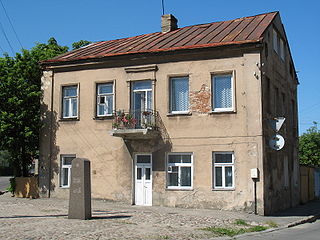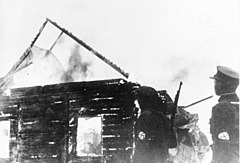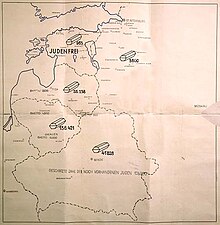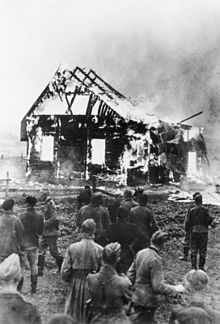
The Final Solution or the Final Solution to the Jewish Question was a Nazi plan for the genocide of individuals they defined as Jews during World War II. The "Final Solution to the Jewish question" was the official code name for the murder of all Jews within reach, which was not restricted to the European continent. This policy of deliberate and systematic genocide starting across German-occupied Europe was formulated in procedural and geopolitical terms by Nazi leadership in January 1942 at the Wannsee Conference held near Berlin, and culminated in the Holocaust, which saw the murder of 90% of Polish Jews, and two-thirds of the Jewish population of Europe.
The Lithuanian Activist Front or LAF was a Lithuanian underground resistance organization established in 1940 after the Soviets occupied Lithuania. Its goal was to free Lithuania and regain its independence. The LAF planned and executed the June uprising and established the short-lived Provisional Government of Lithuania, which disbanded after a few weeks. The Nazi authorities banned the LAF in September 1941. Its role in the three World War II invasions of Lithuania and the massacre of 95% of Lithuania's Jewish population remains ambiguous and the topic of conflicting information and opinion.
Marcinkonys or Marcinkańce Ghetto was a small Jewish ghetto established during the Holocaust in Marcinkonys. It existed from around November 1941 to November 1942 and housed 300 to 400 Jews.

The Kovno Ghetto was a ghetto established by Nazi Germany to hold the Lithuanian Jews of Kaunas (Kovno) during the Holocaust. At its peak, the ghetto held 29,000 people, most of whom were later sent to concentration and extermination camps, or were shot at the Ninth Fort. About 500 Jews escaped from work details and directly from the ghetto, and joined Jewish and Soviet partisan forces in the distant forests of southeast Lithuania and Belarus.
The Lithuanian Security Police (LSP), also known as Saugumas, was a local police force that operated in German-occupied Lithuania from 1941 to 1944, in collaboration with the occupational authorities. Collaborating with the Nazi Sipo and SD, the unit was directly subordinate to the German Kripo. The LSP took part in perpetrating the Holocaust in Lithuania, persecuting the Polish resistance and communist underground.
Algirdas Klimaitis was a Lithuanian paramilitary commander, infamous for his role in the Kaunas pogrom in June 1941. Klimaitis was likely an officer in the Lithuanian Army. During the pre-war years he was editor of the tabloid Dešimt centų. His attitudes shifted to anti-communism and antisemitism. He joined the Voldemarininkai movement.
Ypatingasis būrys or Special Squad of the German Security Police and SD was a killing squad operating in the Vilnius Region in 1941–1944. The unit, primarily composed of Lithuanian volunteers, was formed by the German occupation government and was subordinate to Einsatzkommando 9 and later to Sicherheitsdienst (SD) and Sicherheitspolizei (Sipo).p.15 The unit was subordinated to German police, and had no official autonomy. In Polish they were colloquially called strzelcy ponarscy.

Juozas Ambrazevičius or Juozas Brazaitis, was a Nazi collaborator and Lithuanian literary historian who became prime minister when the Nazis routed the Soviets from Lithuania. His own ideology and views are disputed.
The issue of Polish and Lithuanian relations during the World War II is a controversial one, and some modern Lithuanian and Polish historians still differ in their interpretations of the related events, many of which are related to the Lithuanian collaboration with Nazi Germany and the operations of Polish resistance organization of Armia Krajowa on territories inhabited by Lithuanians and Poles. Several common academic conferences started bridging the gap between Lithuanian and Polish interpretations, but significant differences remain.

The Ponary massacre, or the Paneriai massacre, was the mass murder of up to 100,000 people, mostly Jews, Poles, and Russians, by German SD and SS and the Lithuanian Ypatingasis būrys killing squads, during World War II and the Holocaust in the Generalbezirk Litauen of Reichskommissariat Ostland. The murders took place between July 1941 and August 1944 near the railway station at Ponary, a suburb of today's Vilnius, Lithuania. 70,000 Jews were murdered at Ponary, along with up to 2,000 Poles, 8,000 Soviet POWs, most of them from nearby Vilnius, and its newly formed Vilna Ghetto. Along with 90 LTDF officers who refused to carry orders by the Germans after the Battle of Murowana Oszmianka.
The Lithuanian TDABattalion or simply TDA, was a paramilitary battalion organized in June–August 1941 by the Provisional Government of Lithuania at the onset of Operation Barbarossa. Members of the TDA were known by many names such as Lithuanian auxiliaries, policemen, white-armbands, nationalists, rebels, partisans, resistance fighters or Schutzmannschaften. TDA was intended to be the basis for a future independent Lithuanian Army, but it was taken over by Nazis and reorganized into the Lithuanian Auxiliary Police Battalions. The original TDA eventually became the 12th and the 13th Police Battalions. These two units took an active role in mass killings of the Jews in Lithuania and Belarus. According to the Jäger Report, the TDA battalion's members killed about 26,000 Jews between July and December 1941.

The Kaunas pogrom was a massacre of Jews living in Kaunas, Lithuania, that took place on 25–29 June 1941; the first days of Operation Barbarossa and the Nazi occupation of Lithuania. The most infamous incident occurred at the garage of NKVD Kaunas section, a nationalized garage of Lietūkis, an event known as the Lietūkis Garage Massacre. There several dozen Jewish men, allegedly associates of NKVD, were publicly tortured and executed on 27 June in front of a crowd of Lithuanian men, women and children. The incident was documented by a German soldier who photographed the event as a man, nicknamed the "Death Dealer", beat each man to death with a metal bar. After June, systematic executions took place at various forts of the Kaunas Fortress, especially the Seventh and Ninth Fort.

The Kaunas massacre of October 29, 1941, also known as the Great Action, was the largest mass murder of Lithuanian Jews.

The military occupation of Lithuania by Nazi Germany lasted from the German invasion of the Soviet Union on June 22, 1941, to the end of the Battle of Memel on January 28, 1945. At first the Germans were welcomed as liberators from the repressive Soviet regime which had occupied Lithuania. In hopes of re-establishing independence or regaining some autonomy, Lithuanians had organized a Provisional Government. It lasted six weeks.
RollkommandoHamann was a small mobile unit that committed mass murders of Lithuanian Jews in the countryside in July–October 1941, with an estimated death toll of at least 60,000 Jews. The unit was also responsible for many murders in Latvia from July through August 1941. At the end of 1941 the destruction of Lithuanian Jewry was effectively accomplished by Hamann's unit in the countryside, by the Ypatingasis būrys in the Ponary massacre, and by the Tautinio Darbo Apsaugos Batalionas (TDA) in the Ninth Fort in Kaunas. In about six months an estimated 80% of all Lithuanian Jews were killed. The remaining few were spared for use as a labor force and concentrated in urban ghettos, mainly the Vilna and Kaunas Ghettos.
Švenčionys, Svintsyan or Święciany Ghetto was a Jewish ghetto in Nazi-occupied Švenčionys. It operated from July 1941 to April 1943. At its peak, the ghetto housed some 1,500 prisoners. It was located in what today is a city park; the location is marked by a wooden menorah carved by Juozapas Jakštas.
Jacob Gens was the head of the Vilnius Ghetto government. Originally from a merchant family, he joined the Lithuanian Army shortly after the independence of Lithuania, rising to the rank of captain while also securing a college degree in law and economics. He married a non-Jew and worked at several jobs, including as a teacher, accountant, and administrator.
Bruno Kittel was an Austrian Nazi functionary in the German SS and Holocaust perpetrator who oversaw the liquidation of the Vilna Ghetto in September 1943. Kittel became known for his cynical cruelty. He disappeared after the war.

Elena Kutorgienė was a Lithuanian physician who resisted the Nazi occupation of Lithuania during World War II. Kutorgienė and her son took Jewish children out of the Kovno Ghetto and placed them in gentiles' homes to save them from genocide. She is recognized as Righteous Among the Nations.
Wartime collaboration occurred in every country occupied by Nazi Germany during the Second World War, including the Baltic states. The three Baltic republics of Estonia, Latvia and Lithuania, first invaded and occupied by the Soviet Union in summer 1940, were later occupied by Germany in summer 1941 and incorporated, together with parts of the Byelorussian Soviet Socialist Republic of the U.S.S.R., into Reichskommissariat Ostland. Collaborators with Germany participated in the Eastern Front against the Soviet Union, as well as in the Holocaust, both in and outside of the Baltic States. This collaboration was done through formal Waffen-SS divisions and police battalions, as well as through spontaneous acts during the opening of the war.













